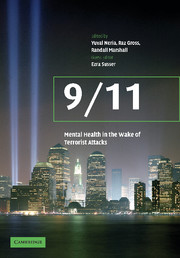Book contents
- Frontmatter
- Contents
- Acknowledgments
- Editors brief bio
- List of contributors
- Foreword
- Part I Introduction
- Part II The psychological aftermath of 9/11
- Part III Reducing the burden: community response and community recovery
- Part IV Outreach and intervention in the wake of terrorist attacks
- 15 Science for the community after 9/11
- Part IV A New York area
- Part IV B Washington, DC
- Part IV C Prolonged-exposure treatment as a core resource for clinicians in the community: dissemination of trauma knowledge post-disaster
- Part V Disasters and mental health: perspectives on response and preparedness
- Index
15 - Science for the community after 9/11
from Part IV - Outreach and intervention in the wake of terrorist attacks
Published online by Cambridge University Press: 27 October 2009
- Frontmatter
- Contents
- Acknowledgments
- Editors brief bio
- List of contributors
- Foreword
- Part I Introduction
- Part II The psychological aftermath of 9/11
- Part III Reducing the burden: community response and community recovery
- Part IV Outreach and intervention in the wake of terrorist attacks
- 15 Science for the community after 9/11
- Part IV A New York area
- Part IV B Washington, DC
- Part IV C Prolonged-exposure treatment as a core resource for clinicians in the community: dissemination of trauma knowledge post-disaster
- Part V Disasters and mental health: perspectives on response and preparedness
- Index
Summary
“… men [and women] of science are becoming conscious of the responsibility towards society conferred by their knowledge, and are feeling it a duty to take a larger part in the direction of public affairs than they have hitherto done.”
– Bertrand Russell, The Scientific Outlook, 1931 (p. 233)Public health models after large-scale disaster always consider the problem of “surge capacity” – that is, how effectively will a community be able to absorb a sudden increase in a particular need for medical intervention. Before the 9/11 disaster, models of such an event – the complete collapse of two of the world's tallest skyscrapers along with the destruction of surrounding buildings would literally have focused on surge capacity for medical treatment, for basic needs (food, clothing, shelter for persons displaced from contaminated dwellings) and social services after dwellings. The totally unexpected public health problem, was the need to address surge capacity for mental health problems and disorders. These chapters document only a few of the programs developed in response.
All epidemiological studies of the mental health consequences of the 9/11 attacks found significant rates of new-onset 9/11 related posttraumatic stress disorder (PTSD) in those directly and indirectly exposed in New York, and, surprisingly, also in persons across the US. Several groups have replicated this finding independently over time (Neria et al., this volume; Galea et al., this volume; Hoven et al., this volume; Cohen-Silver et al., this volume). Because the population base is so large, small percentages translate into large absolute numbers (e.g., a rate of 0.9% in the New York area _ 142,000 persons).
- Type
- Chapter
- Information
- 9/11: Mental Health in the Wake of Terrorist Attacks , pp. 231 - 236Publisher: Cambridge University PressPrint publication year: 2006



